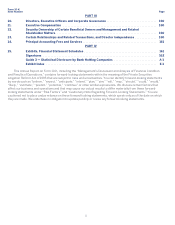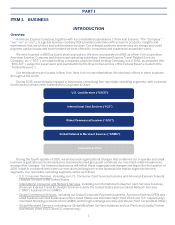American Express 2015 Annual Report Download - page 19
Download and view the complete annual report
Please find page 19 of the 2015 American Express annual report below. You can navigate through the pages in the report by either clicking on the pages listed below, or by using the keyword search tool below to find specific information within the annual report.
• The ability to manage credit and interest rate risk throughout the economic cycle and implement operational
and cost efficiencies
In addition to the discussion in this section, see “Our operating results may suffer because of substantial and
increasingly intense competition worldwide in the payments industry” in “Risk Factors” for further discussion of the
potential impact of competition on our business.
Financing Activities
We meet our funding needs through a variety of sources, including direct and third-party sourced deposits and
debt instruments, such as senior unsecured notes, asset securitizations and secured borrowing facilities. The cost of
funding Card Member receivables and loans is a major expense of our card operations.
Centurion Bank and American Express Bank finance their charge card receivables and credit card loans, in part,
through the issuance of medium-term notes and by accepting consumer deposits in the United States. TRS, Centurion
Bank and American Express Bank also fund receivables and loans through asset securitization programs. American
Express Credit Corporation, a wholly owned subsidiary of TRS, along with its subsidiaries (collectively, “Credco”)
acquires or finances charge card receivables arising from the use of corporate cards issued in the United States and
consumer and corporate charge cards issued in certain countries outside the United States. Credco also acquires or
finances revolving credit card loans arising from the use of consumer cards issued in certain countries outside the
United States. Credco funds the acquisition or financing of receivables and loans principally through the issuance of
medium-term notes.
There is a discussion of our financing activities in “Consolidated Capital Resources and Liquidity” under “MD&A”
and Notes 6 and 9 to our Consolidated Financial Statements. In addition, see “Adverse financial market conditions may
significantly affect our ability to meet liquidity needs, access to capital and cost of capital” in “Risk Factors.”
Deposit Programs
Centurion Bank and American Express Bank accept deposits from individuals through third-party brokerage
networks. American Express Bank also accepts deposits directly from consumers through American Express®
Personal Savings, a set of deposit products, including High-Yield Savings and Certificate of Deposit accounts. As of
December 31, 2015, we had approximately $54.1 billion in total U.S. retail deposits. Our deposit-taking activities
compete with those of other deposit-taking organizations that source deposits through telephone, internet and other
electronic delivery channels, brokerage networks and/or branch locations. We compete primarily in the deposit sector
on the basis of rates and our brand and its attributes.
Card-Issuing Business and Deposit Programs — Regulation
We are subject to a variety of laws and regulations applicable to financial institutions that have become
increasingly complex and robust, and supervisory efforts to apply relevant laws, regulations and policies have become
more intense. Further changes in such laws and regulations or in the regulatory application or judicial interpretation
thereof could continue to impact the manner in which we conduct our business and the costs of compliance. We
regularly review and, as appropriate, refine our business practices in light of existing and anticipated developments in
laws, regulations and industry trends so we can continue to manage our business prudently and consistent with
regulatory requirements and expectations.
Our charge card, consumer lending and deposit operations are subject to extensive regulation in the United
States, including pursuant to:
• The Equal Credit Opportunity Act (which generally prohibits discrimination in the granting and handling of
credit)
• The Fair Credit Reporting Act (“FCRA”), as amended by the Fair and Accurate Credit Transactions Act (“FACT
Act”) (which, among other things, regulates use by creditors of consumer credit reports and credit
prescreening practices and requires certain disclosures when an application for credit is rejected)
• The Credit Card Accountability Responsibility and Disclosure Act of 2009 (the “CARD Act”) (which prohibits
certain acts and practices in connection with consumer credit card accounts)
• The Truth in Lending Act (“TILA”) (which, among other things, requires extensive disclosure of the terms upon
which credit is granted), including the amendments to TILA that were adopted through the enactment of the
Fair Credit and Charge Card Disclosure Act (which mandates certain disclosures on credit and charge card
applications)
• Regulation Z (which implements TILA and was amended by the Federal Reserve to extensively revise the open
end consumer credit disclosure requirements and implement the requirements of the CARD Act)
8
























